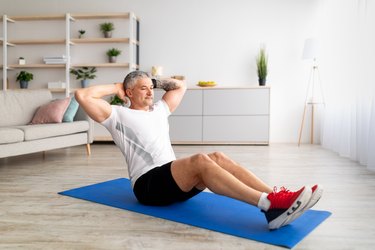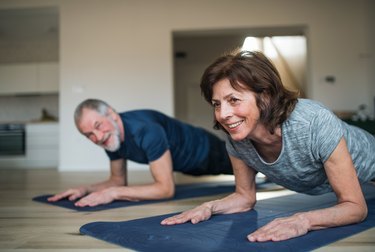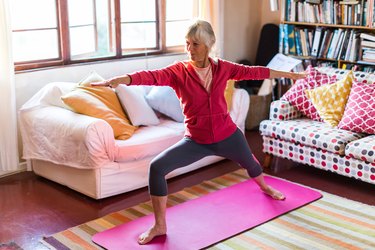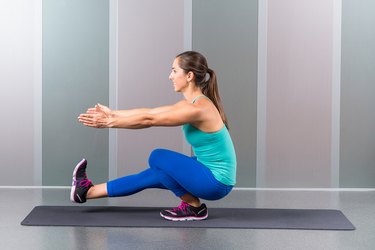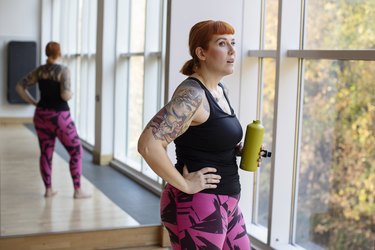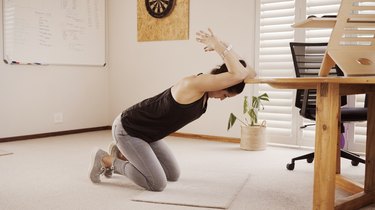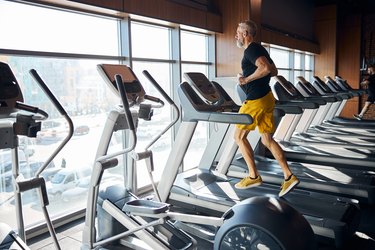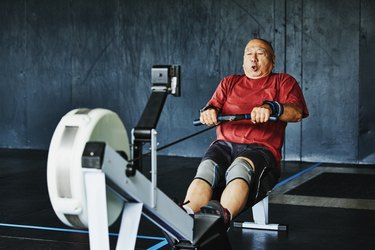
There are so many reasons to celebrate reaching the menopausal transition. For starters, you never have to deal with period cramps again. Worrying about unplanned pregnancies also becomes a thing of the past.
But, as your progesterone and estrogen hormone levels take a nose dive in the time leading up to your last period, your body becomes more susceptible to a host of health issues and side effects. These include hot flashes, anxiety, osteoporosis (a condition in which your bones become weak and brittle), cardiovascular events and sarcopenia (the loss of muscle and strength), as explained in a July 2011 article in the Journal of Midlife Health.
Video of the Day
Video of the Day
The good news? Exercise is a powerful mitigator. In fact, people with high and moderate physical activity levels tend to have less severe menopausal symptoms and are less susceptible to menopause-related health issues compared to those who are less active, according to an August 2019 article in Medicina.
If you're looking to ramp up your workout routine to reap the benefits, know this: Fitness isn't one-size-fits-all. What works for one person may not work for another, so it's important to find a routine that feels good to you.
That said, if you're going through menopause and want to jump-start a more active lifestyle, these expert tips can help you do just that safely and effectively.
1. Start Slow
Never worked out before? It's never too late to start! (Just make sure you get the OK from your doctor first — especially if you have heart problems.) The key to ramping up safely is to start slow and keep your workouts short and sweet.
"Start with 10- or 20-minute workouts twice a week and build up from there," says Tina Tang, CPT, a trainer specializing in working with menopausal people. "For beginners, it's about building an exercise habit and enjoying the activity more than anything else. What you do is not as important as how often you can stick with it."
Mary Claire Haver, MD, an ob-gyn and author of The New Menopause, generally recommends her sedentary menopausal patients kick off their fitness journey by walking. Start with about 10 minutes and slowly build up to more time and increased intensity, she says.
2. Focus on Building Muscle
Strong muscles can actually protect your health as you age by slowing bone loss and weight gain.
After menopause, you may be at an increased risk for fractures and osteoporosis due to bone loss and weight gain in your midsection, "which increases the risk of type 2 diabetes and heart disease," says Stacy De-Lin, MD, gynecology and family planning specialist and associate medical director at Planned Parenthood in Hudson Peconic, New York.
While all exercise benefits health, you must strength train to preserve and build lean muscle mass and maintain healthy bones, explains Tang, who recommends focusing on "the big six" exercises, which mimic everyday movement patterns. These include:
- Squats
- Lunges
- Hinge movements (like glute bridges and deadlifts)
- Pushes (like push-ups or overhead presses)
- Pulls (like rows or lat pulldowns)
- Carries (like a farmer's walk)
If you've never weight trained before, Tang recommends getting a handful of personal training sessions so your trainer can teach you the proper form for basic exercises. If that's not in your budget, consider signing up for a small group fitness class.
"If there are less than eight people, the instructor can really focus on each student and help teach you the basics and correct your form," Tang says.
YouTube videos can also help break down step-by-step instructions and provide corrections for common form mistakes.
3. Train Balance and Stability
Not only can weight training strengthen your muscles and bones, but it can also improve balance, which helps decrease the risk of falls, according to a January 2023 review in the Journal of Clinical Medicine.
While we may trip and get right back up again when we're young, taking a tumble can be more serious later in life. Around 20 percent of falls in the older adults have more severe effects, like a fracture or a head injury, both of which can reduce a person's ability to live independently, according to a February 2020 review in the Indian Journal of Orthopaedics.
In addition to weight training, working balance-specific exercises into your daily routine can be beneficial.
"Balance training cannot be stressed enough. I recommend practicing balance daily, like standing on one foot when brushing your teeth," Dr. Haver says. "Yoga and Pilates can also go a long way to decreasing the risk of falls and fractures with falls by improving strength, balance and flexibility."
Get started with a practice by checking out some classes online or heading to a local yoga or Pilates studio.
4. Add Meditation to the Mix
Meditation isn't a replacement for physical exercise, nor is exercise a substitute for meditation, but it can help to think about them as complementary practices that should be part of your weekly workout routine.
Meditation, especially a practice that includes deep breathing, can help manage the stress of life and menopause-related symptoms, according to the Journal of Mid-life Health article. Dr. De-Lin agrees, adding that "multiple studies have shown that meditation may be associated with fewer menopausal symptoms and can be especially helpful for menopausal people struggling with anxiety and depression."
While clearing your head may not cure your hot flashes, being more centered can help you cope with the stress that often comes along with navigating "the change."
So, next time you're cooling down after a workout, why not grab your headphones and do a quick 5-minute meditation? There are tons of free videos on YouTube, as well as plenty of apps that offer a plethora of options. (These are a few of our favorites!)
5. Prioritize Recovery
Of course, the work you put in at the gym is important. But how you recover and refuel afterward is even more paramount to your overall wellness. This holds especially true after menopause.
"After a tiring workout, you may find you need more recovery than you previously did 5 or 10 years ago — and you should honor that feeling," Tang says.
In practice, this may look like taking a day or two off between workouts and logging plenty of zzzs.
"Regardless of age, sleep is the number one tool for recovery. Our muscles are built while we're sleeping — not during the workout," Tang says. "Sleep is actually more relevant to recovery than any supplement or food."
But that doesn't mean nutrition doesn't matter. Consuming enough protein is vital when working out is part of your regular routine. Not only can it help you maintain muscle, but it can actually aid recovery by giving your muscles the amino acids necessary to repair and rebuild.
However, protein is digested less efficiently as we age, Tang says, so this task gets harder as you move into their post-menopausal years. That means protein consumption should be a top priority.
Aim for 5 to 6.5 ounces of protein a day from various sources like beef, ham, lamb, pork, shellfish, fish, eggs, beans, soy, nuts and seeds to give your muscles what they need to recover and grow, per the USDA's Dietary Guidelines for Americans.
It's best to scatter your protein intake throughout the day, Tang says, so hit the mark by adding a protein-rich food to all your meals and snacks.
6. Kick Up Your Cardio
People who have higher estrogen levels have a lower risk of developing heart disease than those who have lower levels. However, when estrogen levels dip during menopause, its protective effect against heart disease takes a nosedive, too, per a December 2022 article in Archives of Medical Science.
This leaves those who've gone through menopause with a higher risk of developing conditions like coronary artery disease, heart attacks and heart failure than their younger counterparts.
Dr. Haver and Dr. De-Lin both point out that regular cardiovascular exercise can help mitigate the risk of heart disease by lessening stress levels and improving the heart's ability to pump blood. But Tang says that some cardio workouts may be more beneficial than others.
"High-intensity interval training (HIIT) or sprint interval training (SIT) tend to be best for menopausal [people] because they involve doing short bursts of work. You push your heart rate to its upper levels and then recover during the rest periods. For your heart to have the ability to work and recover at higher health levels, you need to train it with this type of work," Tang says.
On the other hand, longer endurance cardio workouts involve a lot of continuous stress on the body, which can raise cortisol levels — something that can negatively affect muscle building and body composition. HIIT and SIT tend to have the opposite effect, aiding muscle building and improving body composition, Tang explains.
HIIT and SIT workouts should only be done between one and three times per week for 20 minutes or less — any more than that is too much stress on the body, no matter your age, Tang says. Want to give these workouts a whirl? Here's exactly how to do a HIIT workout at home and a beginner-friendly sprint workout to try.
7. Listen to Your Body
If something hurts during a workout, stop and try another exercise. If you don't feel ready for a HIIT workout but love walking, great — get after those steps.
If you feel like your workout class is too much for you, don't ignore your intuition. You know your body best, and you should feel empowered to let your body guide you toward a workout routine that's right for you.
Most importantly, if you have any of the medical conditions below, as outlined in the Journal of Midlife Health article, you should speak to your doctor before exercising and contact your health care team if something feels off while you're breaking a sweat:
- Elevated blood pressure
- Valvular heart disease
- Complex ventricular ectopy
- Uncontrolled metabolic disease
- Myocardial infarction
- Uncontrolled arrhythmia
- Unstable angina
- Third-degree heart block
- Acute progressive heart failure
No matter how you decide to move more each day, remember: Fitness should be fun! If it's a drag, you're doing it wrong. So don't be afraid to experiment until you find a routine that you actually look forward to.
- Journal of Midlife Health: "Exercise beyond menopause: Dos and Don’ts"
- Medicina: "High Physical Activity Level May Reduce Menopausal Symptoms"
- Journal of Clinical Medicine: "The Efficacy of Strength Exercises for Reducing the Symptoms of Menopause: A Systematic Review"
- Indian Journal of Orthopaedics: "Falls in Older Adults are Serious"
- USDA: "Dietary Guidelines for Americans"
- Archives of Medical Science: "Menopause and women’s cardiovascular health: is it really an obvious relationship?"
